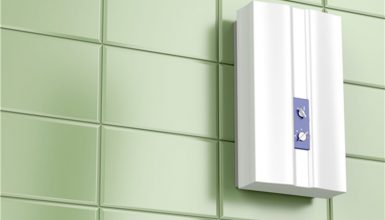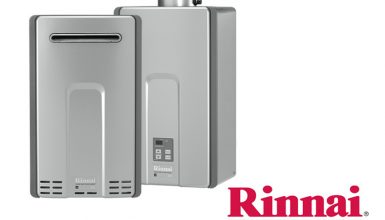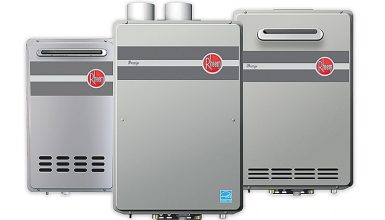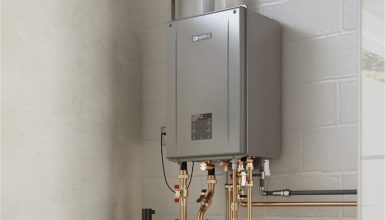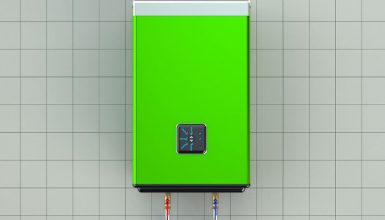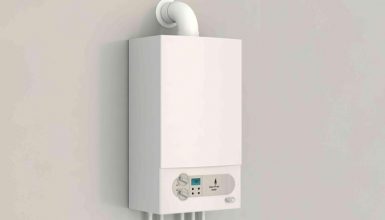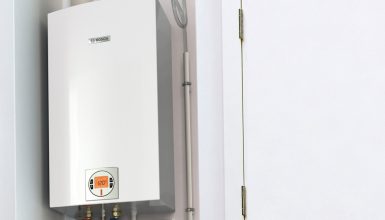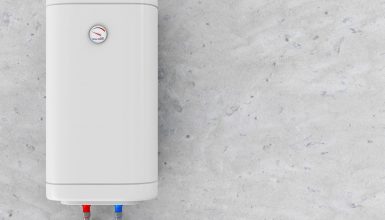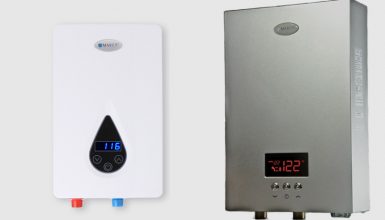Tankless water heaters powered by natural gas are very powerful. They can comfortably serve large households with up to four bedrooms and multiple bathrooms. With a more than satisfactory flow rate, you can expect an average of 3 simultaneous full-flow showers at any given time. Running out of hot showers at any point should be long gone.
Today we are going to take a look at some of the best gas tankless water heaters on the market (in every price bracket). At the end of this article, you will find detailed buyers guide on what to look out for in a good heater (and what to avoid in a bad one). By the end of this (long) article, you should be ready to make the perfect choice for you and your family.
Let’s get started.
Best Gas Tankless Water Heater Comparison




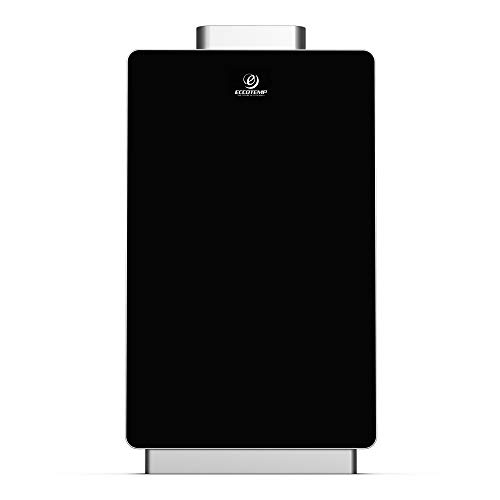





1. Marey Gas 10L Tankless Water Heater

For those of you with a limited budget (and a small household), this heater from Marey provides an affordable option that is of a very reasonable quality. Marey might not have the big name brand recognition that some of the other heaters on this list have, but their products are more than acceptable (by anyone’s standards).
Pros
For this section, we ask that you set your expectations accordingly. This is a budget heater with a budget price tag. It’s not the biggest, best, or most efficient unit in the world. But it is cheap (which is the biggest plus point this heater has going for it).
For the cost, the 3.1 GPM rating is actually quite impressive. It’s more than enough for a small household that only has one or two people living in it. You can probably shower and use a dishwasher at the same time with this heater, but we wouldn’t recommend you try and use anything more than that.
The energy efficiency rating of this heater is about as good as you could expect from a product in this price bracket. It’s rated .84 to .87 (84% – 87% efficient). It’s not a great rating, but for the price, we feel Marey have done ok.
Installation is super easy, and while we always recommend a professional installation – in reality, anyone with a little experience can get this heater up and running with no problems at all.
The warranty provided is generous (considering the price tag of the unit), although it could be a little longer if we were picky. Marey provides a 5-year warranty on all parts as standard, and this can be extended for an additional cost if you wish.
Cons
As you might expect from a budget heater, several things could be improved. But, this is a super cheap product (and we need to keep our expectations realistic). For the cost, we have no real issues with this product, but there are a few things that could definitely be improved.
The .84 – .87 energy efficiency rating is our biggest issue with this product. It’s not the end of the world, and there are worse products on the market in this respect. But this rating will make operating costs around 10% more expensive than a higher quality heater.
Conclusion
This is one of those products that is what it is. It’s not particularly easy to use, it’s not very efficient, and its flow rate is reasonably low. But then again, considering the cost of the unit, it’s a bargain. There are much worse products on the market at this price point, and if this is the kind of budget you have – you could do a lot worse than going with the Marey.
2. Eccotemp i12-NG Indoor Tankless Water Heater

After reviewing the Marey above we couldn’t help ourselves from adding this second budget water heater from Eccotemp as a comparison. On the outside, this looks like a much higher quality product than the Marey (despite being a similar price). But once you get under the hood the two heaters are reasonably similar regarding quality and efficiency.
Pros
Like the Marey, the main thing that’s going to attract you to the Eccotemp is the price (it’s actually a little bit cheaper than the Marey by around $10 or so). Again this is a budget product, so we need to keep expectations realistic.
The main thing we love about this heater is the usability and ergonomics of the unit. Its sleek black exterior looks very fancy (and expensive) despite it being the cheapest product on our list.
At the bottom of this stunning exterior is an amazingly informative and user-friendly LED display that runs across the entire of the bottom of the unit. The current temperature, GPM, and pressure it’s in real time which allows you to see what’s going on easily. The big easy to use power and temperature buttons are illuminated either side of the display (which makes this basic boiler one of the easiest to use on this list).
Cons
Unfortunately for the Eccotemp, there are a few things that make it a slightly inferior boiler to the Marey above. The max GPM of both units is reasonably similar, but the Eccotemp is the weaker product with a 3.0 GPM (the Marey has 3.1 GPM).
Again in terms of energy efficiency, the Eccotemp is lagging behind the Marey with a .79 EF rating (79% efficient). This is a reasonably low rating by anyone’s standards. Your energy bills are going to be around 15% higher than some of the more premium and advanced heaters on the market.
Conclusion
This is a beautifully designed and easy to use product. But in real world terms, we think you should avoid this unit and go for the Marey instead. The Eccotemp’s slightly lower GPM rating is almost negligibly worse, but the .79 EF is the deal breaker for us.
Your bills are going to be around 5% – 6% higher with this compared to the Marey. In our opinion, the only benefit you’re getting in return for the additional running costs is a nice looking unit (that’s probably going to be hidden away anyway).
3. Takagi T-KJr2 Indoor Gas Tankless Water Heater

Takagi is a brand that you probably won’t have heard of before (unless you work in the heating industry). However, we know them – and so do many professionals in our line of work. They are a company that has a reputation for no nonsense quality, they skip some of the bells and whistles, but they make great products that do exactly what you would expect of them.
The T-KJr2 is a mid range natural gas heater that in our opinion is the perfect balance between capability and affordability.
Pros
The main thing you’re going to love about this heater is it’s very respectable 6.6GPM flow rate. There are bigger (more expensive) heaters that have a higher GPM, but in this price bracket, there are not many other products that can really compete with the Takagi.
If you want an idea of what 6.6GPM feels like you can run a shower, your dishwasher, and your washing machine at the same time without noticing the slightest drop in temperature.
Takagi is a company that puts their money where their mouth is when it comes to reliability. They are offering a massive 10-year warranty on the heat exchanger (and a 5-year warranty on all other parts). This is one of the more generous warranties on the market and tells you a thing or two about how much they believe in the quality of their product.
Cons
While the 6.6 GPM flow rate is very respectable, if you have a large family it might struggle. Two showers being used at the same time (along side a washing machine and a dishwasher) may reduce water temperature. If you think this is a situation that can commonly occur in your household, then you may need to look at investing in a unit that has a higher GPM rating.
The energy efficiency of this heater is also something that we feel is lacking. It’s only rated at .81 – .83 (81% – 83% efficient). There are certainly worse heaters on the market in terms of efficiency (but there are also many better heaters too).
Conclusion
This heater is in it’s great value for money. There are not many other options around this price range that can boast of a 6.6GPM rating. The energy efficiency rating is a little bit disappointing, but it’s not the end of the world. However, we would recommend you consider more efficient (but more expensive) models before making your final choice – over the long run it could end up saving you money.
4. Rheem RTG-64DVLN Tankless Natural Gas Water Heater

Rheem is one of the big dogs of the water heater world. Their products command respect and admiration from all involved in the industry. The RTG-64DVLN is an excellent mid range heater that provides excellent efficiency at a very reasonable price point.
Pros
There is not much to not to like about this heater. It’s a stunning combination of design, engineering, and materials technology.
One of its unique selling points is its super low 0.26 GPM minimum flow rate. A problem that lower quality heaters have is that there needs to be a minimum amount of water flow before the heater can activate. When you want to wash dishes or use a light stream of hot water, this can cause issues. However, the low activation rate of the Rheem removes this problem almost entirely.
The max GPM rate 0f 6.4 is 0.2 lower than the Takagi above, but in real world terms it’s almost a negligible difference, and the two products can be considered almost equal in this respect. The .82 EF rating again is basically the same as the Takagi and any difference in efficiency between the two models is going to be minuscule.
Cons
The main issue we have with this heater is that it can only be installed outdoors due to its ventilation design. This could be a benefit in some cases, but drastically reduces the amount of people that can viably use this product.
Conclusion
To be honest, the Takagi and the Rheem are two different products that fulfill two different purposes. One can only be installed indoors, and the other can only be installed outdoors. Apart from that (and the price), these two boilers are exceptionally similar in their performance and reliability. Either of them are great choices that are more than worthy of your consideration.
5. Noritz NRC661-DV-NG Gas Tankless Water Heater

This offering from Nortiz is technically a premium water heater (in our opinion), but its price is so reasonable that it could easily be considered a mid range heater. However you want to categorize it, there is no getting around the fact that this is a serious product that has some serious performance.
Noritz is somewhat of a legendary company in the heating industry. They were the first company in the world to create an electrically controlled tankless water heater (all the way back in 1981). Ever since then they have continued to innovate and push the boundaries of tankless heating technology and remain one of the big players in the water heater world.
Pros
This heater is rated at 6.5 GPM which is more than enough for most medium sized homes. You’ll be able to run most your appliances while taking a shower or two with ease.
In the many decades, Noritz has been in business, they have developed a reputation for customer care that other brands can only dream of matching. When you buy one of their products, you can rest assured that they are always going to be there for you if something goes wrong. This heater (like nearly all their other products) comes with a limited lifetime warranty on most of the important parts.
However, the big show stopping feature for us when it comes to this heater is the EF rating. It’s way better than any of the other mid range offerings available with its massive .92 – .93 rating (92% – 93% efficient). This is about as good as heaters can get efficiency wise, it’s a serious achievement that will save you money in the long run.
Cons
The only downside to this product in our opinion is the price. Considering the performance, we have talked about above we think this product is still great value for money. But if we were picky it could be a little cheaper.
Conclusion
This is a super efficient heater with an amazing GPM rating. However, while it is definitely better than the Takagi, its GPM rating is reasonably similar. It’s a few hundred dollars more expensive but is around 8% more efficient (which amounts to serious savings over the long term).
If this increase in efficiency and performance is worth the additional initial cost – we will leave for you to decide. However, we feel it’s certainly worthy of your consideration.
6. Rinnai RUC98iN Natural Gas Tankless Water Heater

This heater is the Ferrari of the tankless water heater world. It’s powerful, beautiful, efficient, and expensive. However, if you have the budget for it, we highly doubt you will regret the investment.
Pros
Where on earth do we start with a heater as good as this!
The 9.8 GPM rating is the biggest and best on this list. In fact, it’s one of the best GPM ratings of any residential natural gas tankless water heater in the world. If you have a large house that uses a large amount of hot water simultaneously, this is the boiler for you. The GPM is so high we feel you would really have to try hard to use more hot water than it can handle.
The efficiency of this heater is off the charts at .96 (96% efficient). To put that in comparison hot water from this unit would 16% cheaper than the hot water from the budget models at the start of this list. When you are using 9.8 GPM of water, that’s not an insignificant saving.
All this power and efficiency is not unheard of, other brands and models in this price bracket can boast of similar statistics. However, many of the other products are giant monstrous water heaters that take up a huge amount of space. The Rinnai, on the other hand, has been painstakingly designed to be as compact as possible. Despite the huge GPM, this product is not much bigger than heaters that have half its capacity.
As the cherry on top to all of this excellence, Rinnai offers a comprehensive 12-year limited warranty on the heat exchanger, a 5-year warranty on the parts, and a 1-year warranty on labor (which can optionally be extended to 5 years).
Cons
As you might expect, all this performance comes at a cost. There is no getting around it – this is an expensive heater. However, despite the high price tag we genuinely think it’s a bargain considering the efficiency and GPM you are getting. That being said, it wouldn’t hurt for it to be a little more affordable.
Conclusion
If your efficiency or GPM demands are high enough (and you have the budget), this is one of the best heaters in the world. There is nothing we can fault about this product. It represents the cutting edge of natural gas tankless water heater technology. It is more than worthy of your consideration.
How Gas Tankless Water Heaters Work
Before we dive into some of the slightly technical details in this guide, we thought it would be a good idea to give you a brief overview of how tankless water heaters work.
The concept is reasonably simple in theory, but it took quite a while for the technology to advance enough to make them suitable for widespread usage.
As the name suggests, tankless water heaters don’t store water in a tank (this is the main difference between a tankless water heater and a traditional boiler). This provides several benefits but also has a few consequences too.
The main benefit is that you’re never going to run out of hot water. Traditional boilers that use a tank heat up a batch of water which is then available on demand. But when the water in the tank runs out, tough luck – you’ve gotta wait (or take a cold shower).
On the other hand, tankless heaters don’t need to store water in a tank. The way they heat water is by passing it through a pipe that is surrounded by a series of heating elements. The water comes into the heater cold and leaves hot within a matter of seconds.
This is much more efficient than a traditional storage heater and uses much less energy (as none is lost during the storage process). This also means that they are one of the most eco-friendly ways to heat water in your home.
However, there are limitations to this instant and energy efficient water supply. The main issue is a matter of capacity.
Due to the nature of the way the water is heated up (passing through heating elements), there is an inherent restriction on the amount of water that can be heated up at any one time. The amount varies from a heater to heater, but on average you will struggle to get more than 6.5 gallons of hot water per minute (unless you want to pay over the odds).
6.5 gallons sounds like quite a lot of water, but in reality, can get used up pretty quickly. It’s more than enough capacity to run a few appliances and a shower or two at the same time without any issues. But if you live in a large household you’ll notice you start running out of the water if lots of things that need hot water are being used at the same time.
Electric vs. Gas Tankless Water Heater

Tankless water heaters come in two main varieties, electric and gas. Both electric and gas heaters have their strengths and weaknesses. Overall natural gas tankless water heaters are seen to be the most user-friendly and efficient.
- Purchase Price
In terms of upfront cost, electric tankless water heaters are the clear winner. They are much less complex products to design, develop, and produce. As such they are much cheaper to buy.
Buying Tip: Don’t worry too much about the up front cost of the heater, there are long term factors that are more important economically.
- Installation Cost
Again electric tankless water heaters are the winner in this section. Their installation costs are usually much lower than a gas unit. This is because for a natural gas tankless water heater you’re going to need to install proper venting (which is a reasonably large job).
However, installing an electric unit is not exactly a straight forward job either. You need to ensure that your homes current electricity supply are rated high enough to enable operation of a heater. If you had a previous electric heater, this may not be an issue, but in all other cases, you may find yourself needing to upgrade your homes electricity supply.
Buying Tip: If you already have a traditional gas water heater this ventilation is probably already in place. In this instance installation costs are comparable between electric and gas.
- Flow Rates
Flow rates are one of the biggest things you should pay attention to when it comes to choosing a water heater. And tankless gas heaters are the undisputed winner here.
As we mentioned earlier the amount of water per minute that can be produced is the biggest weakness of tankless heaters (electric or gas).
“Flow rate” is the name of the metric that is used to indicate how much hot water you can expect per minute.
Buying Tip: When shopping around, get a heater that has the highest flow rate you can afford. It’s the most important factor.
Some of the biggest, best (and most expensive) gas water heaters can provide a massive 9 gallons of water per minute. This is more than enough for most homes to use several hot water sources at once without noticing any kind of drop in temperature.
The best electric tankless water heaters can do around 9 gallons per minute too. However, things are a little more complicated with the electric models. Their flow rate depends on the external temperature.
For example, the 9 gallons per minute electric tankless water heater we mentioned above would only be able to provide around 3 to 4 gallons per minute in the winter months. Colder water takes more time to heat up.
Gas heaters can instantly provide more fuel to keep the heating elements hot, but electric heaters are limited by the amount of electricity they can handle. This means that with electric water heaters the water needs to stay in the pipes longer for it to heat up when cold (which results in a lower flow rate).
- Operating Costs
Operating costs are the biggest expense of any water heater. Many people forget this when shopping around and get a cheaper model (but end up paying much more over the long run). This is how they compare:
- Propane gas tankless water heaters are the most expensive units to run
- Electric tankless water heaters are cheaper to run than propane gas heaters.
- Natural gas tankless water heaters are cheaper than both electric and propane gas heaters
Something to bear in mind is that over the next decade or so natural gas prices are set to rise slowly. This may mean that in the future gas and electric heater operating costs could be reasonably similar. Either way, gas heaters are the most energy efficient (and the cheapest to run) at this time.
Sizing Gas Tankless Water Heaters
How to Install a Gas Tankless Water Heater
FAQ
[expand title=”If I turn on my tankless water heated tap, can I get hot water instantly?”]
Unfortunately, this is not the case. One of the most commonly held misconceptions regarding tankless water heating systems, is that they provide on demand heating instantly. This is not true across the board.
Unless your tankless water heating system is located right next to where you will be using the water, there is some waiting time involved because you would have to flush out the cold water in the system before the heated water gets to the spot where you’re going to be using it.[/expand]
[expand title=”If I install a tankless water heating system, will I have to get my gas line modified?“]
Absolutely! Tankless water heaters require larger gas lines because they need a lot of gas. In fact, their gas requirements are much higher than tank-based water heaters.
You need a lot more gas to provide the energy needed to heat up the water going through your water pipes quickly. The actual increase your gas tanks will need totally depends on the specific tankless water heater model you’d like to get installed in your home.
It also depends on how far this unit is from your gas meter. Still, the minimum gas line required size by most models is 3/4″.
More recent models actually require a smaller gas line. Some of the newer tankless water heater systems only require a ½”. Regardless of which size, make sure that your gas company ensures enough pressure for the gas line.[/expand]
[expand title=”Since gas tankless water heater has a higher BTU rating, does this mean that it will use up more gas?”]
Not necessarily. Keep in mind that the amount of heating energy or BTUs your system uses to heat up water is the same.
This is hard for a lot of people to believe, but think of it this way. Imagine you have two pots of water, exact same pot, and exact same amount of water. The only difference is that one of the pots is set on a high stove setting. The other one is set to low heat. The amount of gas flowing through the stove will be absolutely the same.
The sole difference between these two pots of boiling water is the amount of time each will take for your water to reach a boiling point.
The tankless water heating systems are simply set to high heat, whereas the traditional tank-based water heating systems are set to low heat.[/expand]
[expand title=”How gas tankless water heater saves energy?”]
This comes from the higher efficiency enjoyed by tankless water heating systems. You only need gas when you need to heat up water. This is not the case with tank-based water heating system where your system heats up water on a 24/7 basis regardless of whether you need hot water or not.
The tank-based system ensures that you have water when you need it but you burn up a lot of energy to maintain the water heat setting. [/expand]
[expand title=”Why do I need electricity for my gas tankless water heating system?”]
Keep in mind that your gas tankless water heating system doesn’t use electricity to heat up water. Instead, it just requires electric input for its ignition system so it can light the gas piped through the unit.
This ignition system requires a 120V AC power source. With that said, check with your local jurisdiction’s building codes regarding the setting of your electrical connection. Some cities in the United States prohibit the use of extension cords when connecting any kind of fixed electrical device to your wall power outlet.
While tankless water heating systems are powered only by propane and natural gas for water heating, this requires electricity for remote control purposes as well as ignition and of course to power the PC board which acts as the electronic command center for the heater.
Thankfully, the electrical parts of the typical tankless water heating system set up actually uses a very little electricity. [/expand]
[expand title=”If I already have a vent system for my home, can I use it for a tankless water heater unit?”]
Absolutely not! Tankless water heaters are required by the building code to only use category 3 type of stainless steel vent. This is an absolute requirement. This category of venting is very resistant to corrosion and ensures a tight-flow of gas.
Corrosion resistance is crucial because when the water heating system operates, it produces a condensate that is mildly acidic. This is a by-product of the combustion process. If your vent system is not corrosion-resistant, the condensation process starts to create holes in the galvanized metal parts of your pipes. This can seriously mess up the internal components of your tankless water heating system.
More crucially, the vent that you use with your system must be very tight to prevent any carbon dioxide from leaking. It has to be gas-tight. Tankless heaters are designed with an exhaust fan that eliminates gas build up.
This is a very different form of gas management compared to tank-based water heating systems that use the natural circulation of air in its location. Another restriction is that piping must be either made of schedule 40CPVC or PVC for the condensation vent of these units. [/expand]
[expand title=”Can tankless water heater units operate using hard water?”]
While many tankless water heating systems work well without the need for water treatment, it is not a good idea to use these systems in areas that use hard water. You would have to use a water softener or some sort of d-scaling system with your water line.
This conditions your water before it reaches your heater. If you do this, you can extend the life of your tankless water heater system you can also reduce the amount of service your unit requires.
If you live in an area that has extremely hard water, it’s a good idea to make sure that you regularly flush out the insides of your system particularly the heat exchanger unit within your tankless water heating system.
If you or your plumber does this, you’ll be able to remove any scale that has built up over time. It also helps if you reduce the temperature of your unit. This can go a long way in avoiding the buildup of scale especially if you water input uses very hard water.[/expand]
[expand title=”What is the average life of a gas tankless water heating system?”]
The average working life of such water heating systems range from 15 up to 20 years. This is quite an improvement compared to the standard tank-type water heating set ups. Those regular set ups usually last at most ten years. They usually need replacement before that time.
If you live in a place where you water supply is particularly hard, you need to invest in a proper water treatment system to make sure your tankless water heater unit last 15-20 years. [/expand]
[expand title=”What kind of maintenance will a gas tankless water heating system regularly require?”]
These units need two kinds of maintenance. You need to do this periodically. Do these and your tankless water heating system will continue to run smoothly and live to its full product life.
First, you need to check the screen filter built into your line. Look for any sign of debris. How frequently should you check? It all depends on how hard your water is. The harder your water, the more frequently you should check.
Second, you need to flush out your tankless water heating system from time to time. Again, the frequency of flushing depends on the overall water quality of your system if live in an area where there’s very hard water with a lot of line and scale. You might want to flush more regularly.
With constant flushing, you reduce or even prevent the buildup of line and scale. Don’t do this yourself. You should ask as professional water heating system installer to do this for you. [/expand]
[expand title=”Does it make sense for homeowners to install tankless water heating systems by themselves?”]
To get optimal performance from your heating system, you need to contact a licensed and experienced plumber, gas fitter and service technician. You need these three people to install your tankless water heating system. If you try to do it yourself, there might be serious issues with the installation which can void your warranty.
Also, your system may not work as advertised. It can cost a little bit more but it’s always a good idea to get qualified and experienced people to do the installation work so you can avoid unnecessary headaches down the road.[/expand]

